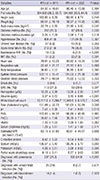1. Winokur PL, Canton R, Casellas JM, Legakis N. Variations in the prevalence of strains expressing an extended-spectrum beta-lactamase phenotype and characterization of isolates from Europe, the Americas, and the Western Pacific region. Clin Infect Dis. 2001; 32:S94–S103.
2. Paterson DL, Ko WC, Von Gottberg A, Mohapatra S, Casellas JM, Goossens H, Mulazimoglu L, Trenholme G, Klugman KP, Bonomo RA, et al. International prospective study of Klebsiella pneumoniae bacteremia: implications of extended-spectrum beta-lactamase production in nosocomial infections. Ann Intern Med. 2004; 140:26–32.
3. Burwen DR, Banerjee SN, Gaynes RP. Ceftazidime resistance among selected nosocomial gram-negative bacilli in the United States. National Nosocomial Infections Surveillance System. J Infect Dis. 1994; 170:1622–1625.
4. Itokazu GS, Quinn JP, Bell-Dixon C, Kahan FM, Weinstein RA. Antimicrobial resistance rates among aerobic gram-negative bacilli recovered from patients in intensive care units: evaluation of a national postmarketing surveillance program. Clin Infect Dis. 1996; 23:779–784.
5. Kang CI, Kim SH, Bang JW, Kim HB, Kim NJ, Kim EC, Oh MD, Choe KW. Community-acquired versus nosocomial Klebsiella pneumoniae bacteremia: clinical features, treatment outcomes, and clinical implication of antimicrobial resistance. J Korean Med Sci. 2006; 21:816–822.
6. Jacoby GA, Munoz-Price LS. The new beta-lactamases. N Engl J Med. 2005; 352:380–391.
7. Kang CI, Wi YM, Lee MY, Ko KS, Chung DR, Peck KR, Lee NY, Song JH. Epidemiology and risk factors of community onset infections caused by extended-spectrum β-lactamase-producing Escherichia coli strains. J Clin Microbiol. 2012; 50:312–317.
8. Lee JA, Kang CI, Joo EJ, Ha YE, Kang SJ, Park SY, Chung DR, Peck KR, Ko KS, Lee NY, et al. Epidemiology and clinical features of community-onset bacteremia caused by extended-spectrum β-lactamase-producing Klebsiella pneumoniae. Microb Drug Resist. 2011; 17:267–273.
9. Park YS, Adams-Haduch JM, Shutt KA, Yarabinec DM 3rd, Johnson LE, Hingwe A, Lewis JS 2nd, Jorgensen JH, Doi Y. Clinical and microbiologic characteristics of cephalosporin-resistant Escherichia coli at three centers in the United States. Antimicrob Agents Chemother. 2012; 56:1870–1876.
10. Kato S, Chmielewski M, Honda H, Pecoits-Filho R, Matsuo S, Yuzawa Y, Tranaeus A, Stenvinkel P, Lindholm B. Aspects of immune dysfunction in end-stage renal disease. Clin J Am Soc Nephrol. 2008; 3:1526–1533.
11. Fejfarová V, Jirkovská A, Petkov V, Boucek P, Skibová J. Comparison of microbial findings and resistance to antibiotics between transplant patients, patients on hemodialysis, and other patients with the diabetic foot. J Diabetes Complications. 2004; 18:108–112.
12. D'Agata E, Venkataraman L, DeGirolami P, Weigel L, Samore M, Tenover F. The molecular and clinical epidemiology of enterobacteriaceae-producing extended-spectrum beta-lactamase in a tertiary care hospital. J Infect. 1998; 36:279–285.
13. Annane D, Bellissant E, Cavaillon JM. Septic shock. Lancet. 2005; 365:63–78.
14. Don BR, Kaysen G. Serum albumin: relationship to inflammation and nutrition. Semin Dial. 2004; 17:432–437.
15. Bailey KV, Ferro-Luzzi A. Use of body mass index of adults in assessing individual and community nutritional status. Bull World Health Organ. 1995; 73:673–680.
16. Chandra RK. Interactions of nutrition, infection and immune response: immunocompetence in nutritional deficiency, methodological considerations and intervention strategies. Acta Paediatr Scand. 1979; 68:137–144.
17. Merritt RJ, Kalsch M, Roux LD, Ashley-Mills J, Siegel SS. Significance of hypoalbuminemia in pediatric oncology patients: malnutrition or infection? JPEN J Parenter Enteral Nutr. 1985; 9:303–306.
18. Dahn MS, Jacobs LA, Smith S, Lange MP, Mitchell RA, Kirkpatrick JR. The significance of hypoalbuminemia following injury and infection. Am Surg. 1985; 51:340–343.
19. Roy S, Sen CK, Kobuchi H, Packer L. Antioxidant regulation of phorbol ester-induced adhesion of human Jurkat T-cells to endothelial cells. Free Radic Biol Med. 1998; 25:229–241.
20. Mandell LA, Wunderink RG, Anzueto A, Bartlett JG, Campbell GD, Dean NC, Dowell SF, File TM Jr, Musher DM, Niederman MS, et al. Infectious Diseases Society of America/American Thoracic Society consensus guidelines on the management of community-acquired pneumonia in adults. Clin Infect Dis. 2007; 44:S27–S72.
21. Zilberberg MD, Shorr AF. Epidemiology of healthcare-associated pneumonia (HCAP). Semin Respir Crit Care Med. 2009; 30:10–15.
22. Pop-Vicas A, Mitchell SL, Kandel R, Schreiber R, D'Agata EM. Multidrug-resistant gram-negative bacteria in a long-term care facility: prevalence and risk factors. J Am Geriatr Soc. 2008; 56:1276–1280.
23. Pop-Vicas A, Strom J, Stanley K, D'Agata EM. Multidrug-resistant gram-negative bacteria among patients who require chronic hemodialysis. Clin J Am Soc Nephrol. 2008; 3:752–758.
24. Wiener J, Quinn JP, Bradford PA, Goering RV, Nathan C, Bush K, Weinstein RA. Multiple antibiotic-resistant Klebsiella and Escherichia coli in nursing homes. JAMA. 1999; 281:517–523.
25. Lautenbach E, Patel JB, Bilker WB, Edelstein PH, Fishman NO. Extended-spectrum beta-lactamase-producing Escherichia coli and Klebsiella pneumoniae: risk factors for infection and impact of resistance on outcomes. Clin Infect Dis. 2001; 32:1162–1171.
26. Szilágyi E, Füzi M, Böröcz K, Kurcz A, Tóth A, Nagy K. Risk factors and outcomes for bloodstream infections with extended-spectrum beta-lactamase-producing Klebsiella pneumoniae; findings of the nosocomial surveillance system in Hungary. Acta Microbiol Immunol Hung. 2009; 56:251–262.
27. Shorr AF, Zilberberg MD, Micek ST, Kollef MH. Prediction of infection due to antibiotic-resistant bacteria by select risk factors for health care-associated pneumonia. Arch Intern Med. 2008; 168:2205–2210.
29. Wilson AP, Ridgway GL. Reducing hospital-acquired infection by design: the new University College London Hospital. J Hosp Infect. 2006; 62:264–269.







 PDF
PDF ePub
ePub Citation
Citation Print
Print




 XML Download
XML Download